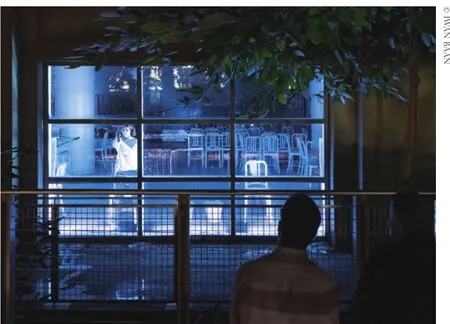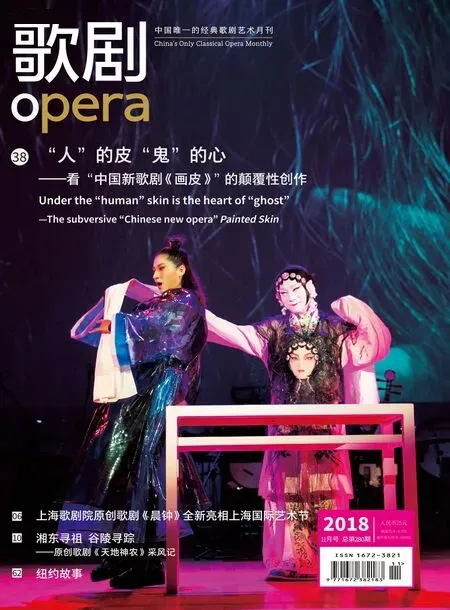紐約故事
文:司馬勤(Ken Smith) 編譯:李正欣
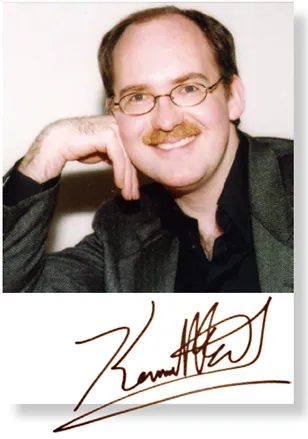
Musical America
)每年年底的節日派對、紐約愛樂樂團春節音樂會與卡內基音樂廳演出季開幕盛會。其實,三者中選其二已經足矣。今年樂季截至目前,我僅出席了卡內基音樂廳演出季開幕晚宴。當天的盛況,與很多類似的場合相仿,基本上就是找個借口讓大家在一起慶祝。在演出后,捐出巨額款項的善長仁翁共聚一堂,參加衣香鬢影的晚宴。換句話說,演出只是雞尾酒會與晚宴的間場。
但是,要評價間場表演的話,卡內基還真算是選了一個不錯的樂隊。這個樂團的水平很高,但對于他們來說,演出曲目簡單至極,只能算得上大眾音樂會程度罷了——第一首樂曲是格什溫的《古巴序曲》,最后一首是《美國人在巴黎》。兩首樂曲之間是兩位女高音——蕾內·弗萊明(Renée Fleming)與奧德拉·麥克唐納(Audra Macdonald)輪流獻唱(后來也有兩人齊唱)。一切都令人愜意,直至她們走上臺時,手持著……話筒。我把目光移至過道另一邊、坐在前兩排的安東尼·托馬西尼(Anthony Tommasini),看看他有什么反應。
過去20多年來,這位《紐約時報》的首席音樂評論家是反對聲樂擴音運動的主導者之一。那些堅守傳統的人有著他們一系列的準則,而安東尼的清單上最重要的一欄,就是全面譴責音樂廳或歌劇院備有話筒。他的理由似乎很明確:無論是演出場地或劇目本身,存在的年代遠比電子擴音科技的發明要早得多。當歌唱家拿著話筒時,你如何去判斷他們自然原聲的水準?對安東尼來說,擴音就相當于為聲音“整容”。
我看得不太清楚,但安東尼好像在微笑。是他近年回心轉意了嗎?還是人到中年,“柔化”了本來的高標準嗎?最有可能的是,他抱著“歡聚”的心情,暫時撇開苛刻的標準,直至翌日舊金山交響樂團演奏斯特拉文斯基專場的時候。
說真的,就托馬西尼先生堅決抵制擴音這個觀點,我并不認同。大量近年來的作品——我是指,比我要年輕的那些——它們的創作初衷已經考慮到擴音問題。自法蘭克·辛納屈(Frank Sinatra,1915~1998,美國歌手、影視演員)的時代開始,話筒早已成為我們感知聲音的一個不可或缺的重要組成部分——而辛納屈肯定要比托馬西尼早出生。向話筒和電子擴音宣戰,就好比在今天突然試圖禁止使用電吉他一樣。
但那個晚上,我覺得自己被拉到了安東尼的陣營。對于用不用話筒我不發表意見;但沒有好好地利用話筒這讓我十分不滿。
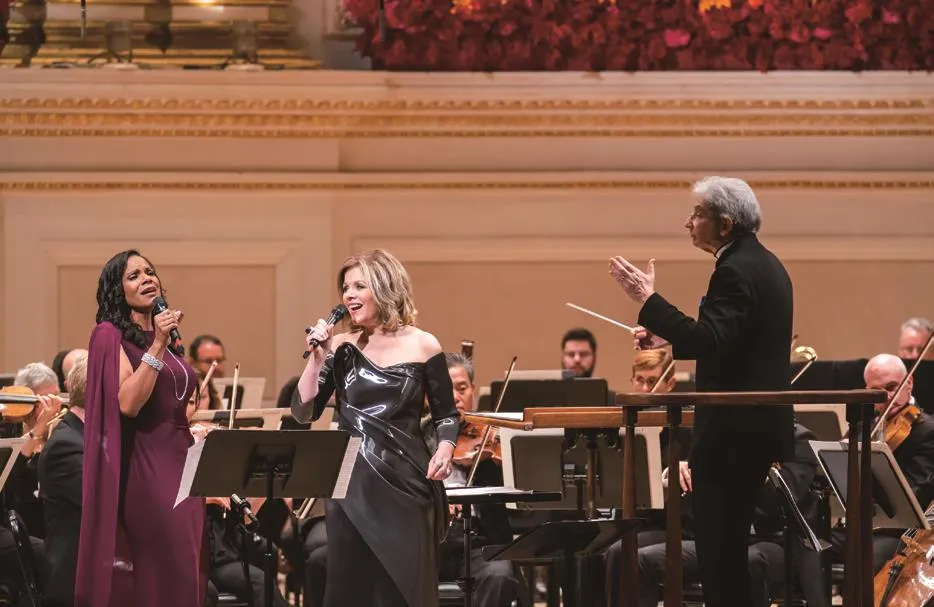
卡內基音樂廳演出季開幕演出,蕾內.弗萊明(中)與奧德拉.麥克唐納(左)(攝影:李之中)
電吉他這個比喻其實十分嚴肅。盡管歌唱家從一學唱歌的時候開始,老師就喋喋不休地灌輸,聽眾對聲樂藝術的感知最為直接,鋼琴或小提琴就比不上了,因為它們要依賴于作為樂器的木頭“修飾美化”——但是,真實的情況卻不一定是這樣。任何流行歌手都明白話筒的重要性。話筒不只是為了擴大音量;它還可以改變聲音的本質。歌唱家必須把話筒當成樂器,熟知所需的使用技巧。
從藝術造詣上來說,請來弗萊明與麥克唐納當然是聰明之舉。弗萊明可算是美國最負盛名的歌劇演員,麥克唐納則也許是當今百老匯得獎最多的演員。兩人都嘗試過涉足彼此的專業領域。她們在臺上介紹說,兩人不約而同地都錄制了桑德海姆《魔法黑森林》(Into the Woods
,又譯《拜訪森林》)里的《孩子會聽到》(Children Will Listen),外加理查德·羅杰斯《南太平洋》(South Pacific
)中《你必須謹慎地受教》(You’ve Got to Be Carefully Taught)的集錦歌。可惜,對于話筒,只有一位女高音懂得怎樣運用。麥克唐納駕馭這個設備猶如像揮舞自己的手臂那般自然。弗萊明則完全不理會話筒的存在——多么可愛的伎倆,這能把觀眾與她的距離盡量拉近。但是,如果我們去關注聲線的質感與色彩——尤其是音量大小的把控——弗萊明完全忘了最基本的技巧:話筒有時候要靠近,有時候要離遠。
但那僅是一個音樂季的開幕慶典演出,大家都不介意這些小失誤。兩晚后,喬納斯·考夫曼(Jonas Kaufmann)從大都會歌劇院的《西部女郎》(La Fanciulla del West
)排練中請了一天假,在卡內基音樂廳罕見地舉行了獨唱音樂會,由圣路克樂團伴奏。曲目則是德國于兩次世界大戰之間、魏瑪年代的舞臺與電影歌曲,即“柏林的咆哮的20年代”(the Roaring Twenties of Berlin)的流行音樂。而“站”在臺上、考夫曼正前方的——是個話筒。說真的,在我踏入音樂廳前,沒有仔細研究過當天的曲目。我相信這絕不是例外:當晚的很多觀眾都是考夫曼的粉絲,在細看演唱的曲目前,只要把他的名字登出來,整場演出的門票立刻售罄。但我期待的,是這位大家公認的歌劇明星怎樣利用他那強大的票房效應給觀眾演繹他最喜歡的歌曲——比如說,他成長期的曲子,或是演出歌劇中的名曲唱段。

喬納斯.考夫曼在卡內基音樂廳的獨唱音樂會(攝影:李之中)
我們曾經見證過其他這樣的案例:多明戈演唱西班牙傳統的薩蘇埃拉(zarzuelas)、布萊恩·特菲爾(Bryn Terfel)演唱勒納與洛伊(Lerner and Loewe)所寫的百老匯名曲、基莉·迪·卡娜娃演唱格什溫。雖然卡娜娃那張格什溫的錄音被諾曼·萊布雷希特(Norman Lebrecht,著名古典音樂評論家)評為史上最差20張唱片之一——但每一位歌手顯然都在唱一些貼近他們內心的歌。
可是考夫曼那晚的演出令我質疑,他此前有沒有聽過那些歌曲,更不用說伴隨這些歌曲一起成長了。讓我用甜品來做個比喻吧:就像一整盤全都是奶油的點心,幾乎沒有脆皮,更不用說里面的餅餡了。
“我真的不需要話筒。”考夫曼對著卡內基音樂廳的觀眾笑著說,他要證明自己寶刀未老,嗓音還可以繞梁三日。但事實上,他確實需要話筒;只不過他不確定應該如何使用它。羅伯特·斯托爾茲(Robert Stolz)的電影主題曲“在夢里,你讓我做一切”(Im Traum hast du mir alles erlaubt)來自一個話筒駕馭的音響世界;萊哈爾為舞臺創作的《風流寡婦》與《帕格尼尼》選段當然講究傳統歌劇的火力。可惜,考夫曼模糊了這兩種不同的風格,使之變得都平凡無奇,做出來的擴音效果如同籠罩著糖漿般的陰霾——他沒有利用話筒技術來刻畫出不同的音樂風格。
從內容的角度來看,那個晚上不像一場音樂會,更像是新唱片的發行派對。那些曲子要是錄入唱片中,效果肯定要比現場演出好得多,因為錄音師可以進行多層面的調整。但我依舊疑慮重重——雖然考夫曼是歌劇明星,可若是一位懂得怎樣善用話筒的二流歌廳歌手,那些歌曲也許會更加動聽。
***
那周我在卡內基音樂廳待的日子太多了,僅僅騰出一點時間去看《一英里長的歌劇》(Mile-Long Opera
)——那是近期紐約最火爆、最難得一見的制作,一票難求。幾位看過《一英里長》的朋友——他們之中有人寧愿放棄卡內基——忠告我:“記得穿舒服的步行鞋。”事后我終于明白為何只得到這樣的提示,因為要描述《一英里長》真的太難了。提供實用的建議比試圖解釋要容易得多。我們要從“高線公園”(High Line)說起。從前在曼哈頓的西邊有一條荒廢多年的懸空鐵軌,后來被改建為市內公園,如今成為紐約的新地標。今天的高線公園是一個難能可貴的、為市民而建的項目:是旅游勝地,最重要的是為當地人服務。自從差不多十年前建成以來,這個項目一直刺激著鄰近老街區的復興。時至今日,這一帶的新建筑到處林立。
可是,具有前瞻性的Diller, Scofido + Renfro建筑設計公司除了設計高線公園以外,把目光放得更遠。只做建筑,未免太局限。首席建筑師伊麗莎白·迪勒(Elizabeth Diller)的設計理念也將裝置藝術和多媒體制作考慮進去。她認為高線公園的獨特性在于,藝術家可以有機會為它創作特定場所可以展現的新作品。
《一英里長的歌劇》的副標題是“7點鐘的傳記”(“A biography of 7 o’clock”)。一開始,主創團隊找來了不同背景的紐約客,詢問他們“7點鐘對你意味著什么?”收集到的答案——有的平淡無奇,也有的緬懷過去——由詩人安娜·卡森(Anna Carson)與作家克勞蒂亞·朗肯(Claudia Rankine)挑選及整理,然后由普利策得主作曲家大衛·朗(David Lang)譜曲。
迪勒與聯合導演林西·佩辛格(Lynsey Peisinger)合作,在全紐約招募了數百名歌唱家和十多個合唱團,在整個高線公園上形成了沿途的“真人裝置”。讓我用上些流行術語:這場演出既是“場所特定”又是“浸沒式”。跟其他用上這些詞匯定義的作品不同,《一英里長的歌劇》締造出令人信服的魔幻效果。
令我感到興奮的原因是,大家司空見慣的角色被顛覆了。跟通常的劇場演出剛好相反:演員留在原位固定不動,觀眾卻要沿著高線公園走一遭;跟常見的裝置藝術剛好相反,觀眾看到及聽到一個梳理得很清晰(盡管較為分散)的故事;跟習以為常的高大上的歌劇藝術剛好相反,你沒有脅迫感,也不用擔心必須有藝術修養才可以理解這部作品。也可以這樣說:這部歌劇是高度風格化的、在街上無意中聽到陌生人講話的經歷。
演唱者們以個體為單位,排列在整條高架線上,從南入口至北出口都是站立的演員——在途中幾個出口附近,聚集成大型合唱團——他們代表著不同的年齡、種族、聲線和體形。一位歌手的單獨歌詞常常被下一位歌手重復,所以一些簡短的敘述——比如說,對家庭聚餐的回憶——在中年黑人男子、老猶太婦女或年輕越南女孩重復時,產生了截然不同的印象。每每提到附近新建高樓的段落——沿途新建的大廈和周邊的幾棟建筑也被納入演出中,某些面對高線公園的大窗戶刻意地燈火通明,演員在里面表述著相關的歌詞——顯然,這些場景中突顯的老區已不復存在,我們只能抱著懷念。是的,這場演出也有運用到話筒——作品進行到尾聲的北出口。在那里,電子音響把街道的雜聲構成全方位立體聲,并且加入了人聲。
有些表演者似乎是喃喃自語,有些則渴望跟觀眾打成一片。偶爾,演員們會與觀眾四目相接,然后又移開視線。倘若是在藝術圈工作的觀眾,很有可能在演員群中碰到老朋友。盡管我不太確定演出的觀眾須知,主辦方提醒大家避免說話,但允許非強制性的身體接觸,鼓勵玩自拍,甚至可以飛吻。
真的是“一英里長的歌劇”嗎?其實,更像是“一小時長的詠嘆調”。歌劇這門藝術在風格上有一個廣為人知的特點——會突然停下敘事的進展,讓劇中人有機會深究感情核心——在這場演出之中,這種情況被連續重復了數百次。整個演出覆蓋的路線其實是1.5英里(如果精細計算的話),觀眾沿途“竊聽”到鄰居們內心深處的想法。盡管我們沿途走了90分鐘,高線公園的時間依舊停留在7點。
這些年來我很少會在走出“場所特定”的藝術演出時,還有那么強烈的“根深蒂固”共鳴之感。我經常到處飛行——看完《一英里長》隔天的凌晨我就又登上飛機——但我感到我的一部分仍然與下西城區牢固地連接著。朋友圈中只有兩位批評《一英里長的歌劇》過分炒作。他們倆都不是紐約人。
Many years ago I discovered how little time you have to spend in New York to make people think you really live there.All you have to do is pick a few key events when everyone you need to see turns up.For me that would be the Musical America holiday party, the New York Philharmonic Chinese New Year gala and opening night of the Carnegie Hall season.Any two of the three will do.
Lately, it’s been only the Carnegie Hall opening.It was, like most gala evenings, basically an excuse for a party.Afterwards, that is, for people paying big bucks.The performance basically marked time between cocktails and dinner.
As party bands go, however, Carnegie Hall could’ve done a lot worse than the San Francisco Symphony.Especially by that orchestra’s standards, the program was really a pops concert—opening and closing with Gershwin’sCuban Overture
andAn American in Paris
,with sopranos Renée Fleming and Audra McDonald alternating numbers in between (and eventually singing together).Everything seemed lovely until they pulled out…the microphones.I looked across the aisle two rows ahead to Anthony Tommasini, just to monitor his reaction.For more than 20 years now, the chief music critic of theNew York Times
has led an unrelenting campaign against amplified voices.Those who take it upon themselves to safeguard tradition have certain benchmarks, and high on Tony’s list is a blanket condemnation of microphones anywhere in the concert hall or opera house.The reasoning seems rather clear:Both the venues and their most representative repertory pre-date electronically enhanced sound.Once you give singers a microphone, how can you judge the quality of their natural voice? For him, amplification is the aural equivalent of plastic surgery.It was hard to tell from the angle, but as I glanced at Tony I think I actually saw him smiling.Was this a recent change of heart? A midlife mellowing of standards?Most likely he too was in party mode, putting his critical values on hold until the San Francisco Symphony’s all-Stravinsky program the next night.
I don’t, frankly, share Mr.Tommasini’s disdain of the microphone.Plenty of recent works—let’s say, pieces younger than me—have been written specifically with amplification in mind.Since the days of, say, Frank Sinatra—who, let’s be honest, was born a bit earlier than Mr.Tommasini—the microphone has been a key component of our sonic consciousness.Waging a campaign against microphones is like trying to ban the electric guitar.
And yet, that night I felt myself being pulled to Tony’s side of the aisle.It wasn’t the microphones I had problems with:it was that they were being used sobadly
.The electric guitar isn’t a frivolous comparison.Despite the fact that singers are taught from the start that they are special—that their artistry touches the listener directly, unlike pianists or violinists who must make their way through a glorified block of wood—that is not always true.Any pop singer is well aware of what the microphone represents.It doesn't just make the voice louder; it changes the very quality of the sound.A singer needs to approach the microphone as an instrument unto itself, aware of specific techniques required.
In terms of artistry, pairing Fleming and McDonald was a stroke of genius.Fleming is arguably America’s most celebrated opera singer, McDonald perhaps Broadway’s most awarded living performer.Each has increasingly crossed over into the other’s professional turf.Each (as they announced that evening) has separately recorded mash-ups of Stephen Sondheim’s “Children Will Listen”fromInto the Woods
and Richard Rodgers’ “You’ve Got to Be Carefully Taught” fromSouth Pacific
without realizing the other one did the same.When it came to the microphone, however, only one of them knew what she was doing.McDonald wielded the device like an extension of her own arm.Fleming ignored its presence completely—a charming ploy,perhaps, to keep it from getting between her and the audience.But when it came to coloristic shadings—and in particular, changes in volume—she forgot the basics of pulling the microphone closer and farther away.
But that was opening night.Lapses are easily forgiven.Two nights later, Jonas Kaufmann (on a break from rehearsals forLa Fanciulla del West
at the Metropolitan Opera) made a rare solo appearance at Carnegie Hall with the Orchestra of St.Luke’s.The program was a mix of Weimar songs from stage and screen dubbed “the Roaring Twenties of Berlin.” And standing on stage directly in front of Kaufmann was…a microphone.To be honest, I didn't really study the songlist before I arrived.Nor, I’m sure, did many Kaufmann fans in the audience.Just his name was enough to fill the hall.What I expected, though, was that a certifiable star would be using some of that box-office appeal to introduce listeners to his guilty pleasures, either the songs he grew up with or the stuff he plays once he’s done singing opera for the night.
We've all seen examples before:Placido Domingo performing zarzuelas, Bryn Terfel singing Broadway songs by Lerner and Loewe, Kiri Te Kanawa crooning Gershwin.But each of those singers—even Te Kanawa,whose Gershwin recording made Norman Lebrecht’s infamous list of 20 worst recordings ever made—was obviously singing something close to their heart.
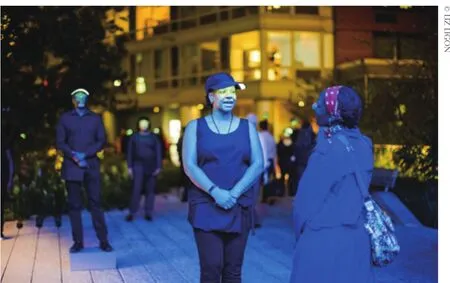
《一英里長的歌劇》劇照
Nothing in Kaufmann’s performances would indicate that he’d even heard the songs before, let alone grown up with them.As a dessert, they were all cream with very little crust, much less a filling.
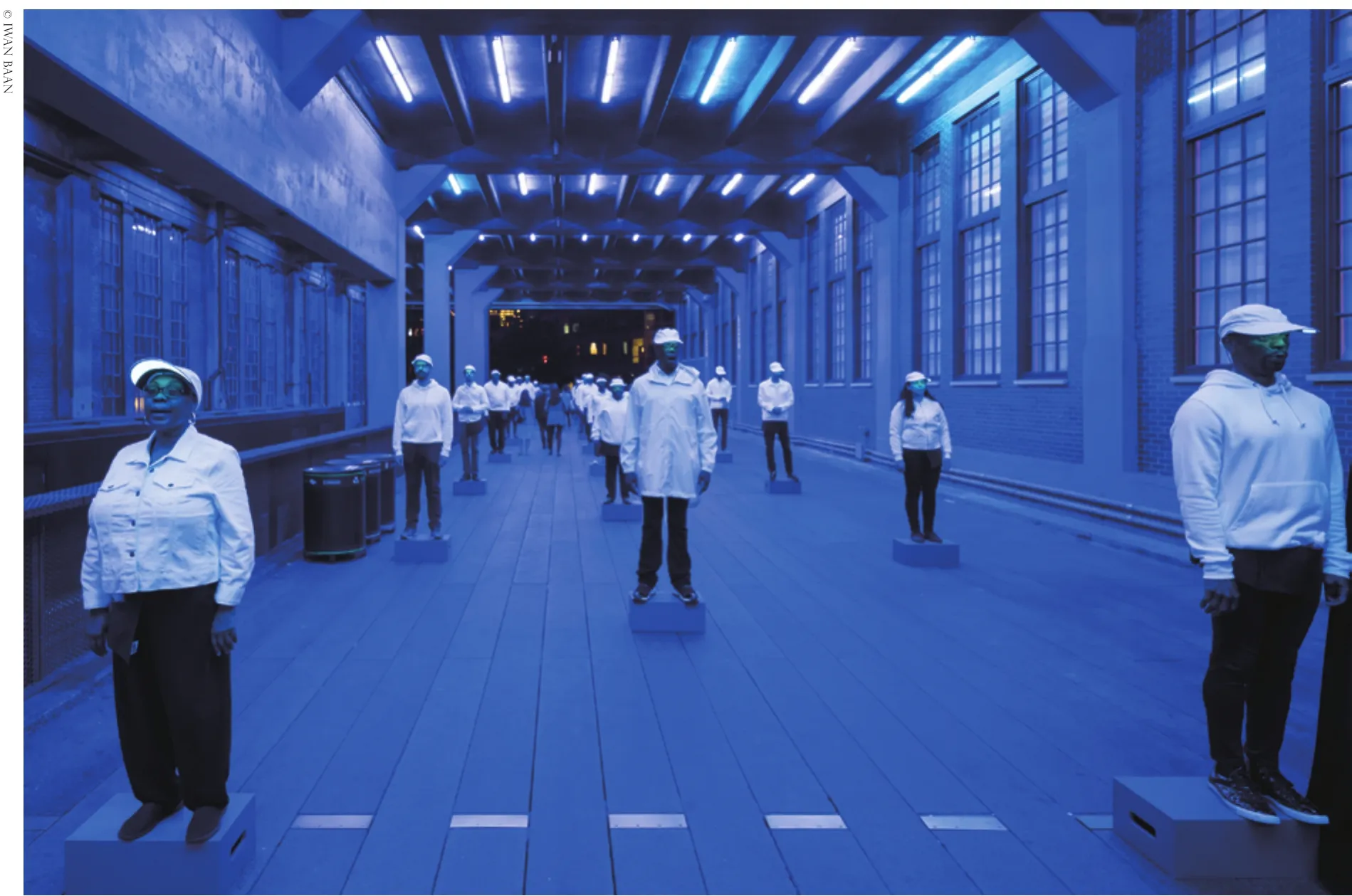
上、右頁:《一英里長的歌劇》劇照
“I don’t really need the microphone,” he told the Carnegie audience, laughing that he wasn’t so old that his voice couldn’t fill the hall.Actually, he did need the microphone; he just wasn’t sure how to use it.Film songs like Robert Stolz’sIm Traum hast du miralleserlaubt
came from a sound world where the microphone reigns supreme.Selections from stage shows such as Lehár’sMerry Widow
andPaganini
required more traditionally operatic firepower.And yet, Kaufmann blurred both styles into a rather generic, amplified syrupy haze rather than using the microphone to hew their distinctions.As far as content goes, the evening was less of a concert program than an album release party.The song selection might fare better on recording, where an engineer could determine the appropriate levels.But somehow I doubt it.Kaufmann’s operatic stardom notwithstanding, the songs would’ve been far better served by a second-rate cabaret singer who knew how to use a mic.
***
I’d spent so much time that week at Carnegie Hall that I barely made it toMile-Long Opera
, which was that week’s hottest ticket in New York.Several of my friends who’d already seen the production—some of whom blew off Carnegie Hall—would only tell me, ”Wear comfortable shoes.” Which in retrospect was probably all I should’ve expected, since offering practical advice forMile-Long Opera
was a lot easier than trying to explain what it was.It all started with the High Line, a former elevated railway on Manhattan’s West Side turned into an iconic urban park.The High Line has become that rarest of civic projects:a tourist destination that is, above all, meant for locals.Since its opening nearly a decade ago, the project has spurred nothing less than an architectural renaissance in a famously rundown neighborhood.
But Diller, Scofido + Renfro, the visionary architecture firm responsible for the High Line, was hardly content just to provide the physical structure.Lead architect Elizabeth Diller, whose design work also embraces installation art and multimedia performance, saw its uniqueness as an opportunity to develop an equally unique piece of site-specific art.
The Mile-Long Opera
, subtitled “A biography of 7 o’clock,” began by asking a broad range of New Yorkers“What does 7 o’clock mean to you?” Responses from the prosaic to the nostalgic were parsed and configured by poet Anna Carson and essayist Claudia Rankine and set to music by the Pulitzer Prize-winning composer David Lang.Working with co-director Lynsey Peisinger, Diller recruited hundreds of singers and more than a dozen choruses throughout the city to fashion essentially a human installation throughout the High Line.It was both “site-specific” and “immersive,” to use a couple of the buzzwords these days.It was also, unlike most works brandishing those credentials, truly magical.
Much of the thrill came from inverting the usual roles.Unlike most theatre,Mile-Long Opera
kept its performers in place while audience members traversed the venue.Unlike most installations, sights and sounds within conveyed a distinct (if diffused) sense of narrative.Unlike most Great Art, there was a very low intimidation factor.If anything, the piece was a highly stylized version of overhearing strangers on the street.Individual singers filled both edges of the High Line—at exit points, they were gathered in large ensembles—representing every conceivable age,ethnicity, vocal style and body type.Individual vocal lines from one singer were often repeated by the next,so a few brief narratives—say, a recollection of a family dinner—created distinctly different impressions when repeated by a middle-aged black man, a old Jewish woman or a young Vietnamese girl.For every account celebrating new high-rises in the neighborhood—and several surrounding buildings were co-opted into the show, with illuminated installations in glass windows to illustrate certain vocal lines—there were telling reminiscences of the old neighborhood lost on the ground.And yes, there were even microphones—though they came mostly at the end, bending a few voices into an electronic soundscape of ambient street noise.
Some performers seemed to mumble to themselves.Others were eager to reach out.Every so often, eyes would meet, making a momentary connection before moving on.Audience members, particularly those who work in the arts, ran the risk of running into performers they knew.I’m not entirely sure of the protocol,but it seemed that speaking was strictly forbidden,non-obtrusive physical contact tolerated, selfies encouraged and air-kisses thoroughly acceptable.
Mile-Long Opera
? "Hour-long aria" was more like it.One stylistic feature that opera is famous for—stopping narrative time while focusing on a character’s emotional core—was repeated sequentially hundreds of times.For about a mile and a half (if we want to be precise), listeners got to eavesdrop on their neighbors’innermost thoughts.After 90 minutes of walking the High Line, it was still 7 o’clock.Rarely have I left a “site-specific” work feeling so sublimely rooted.As much as I fly—and I was on a plane again by midnight that night—part of me still remains fixed to the Lower West Side.I heard from only two people who didn't thinkMile-Long Opera
deserved the hype.They weren’t from New York.